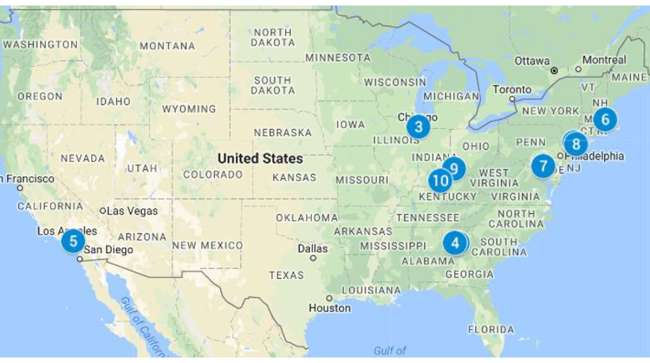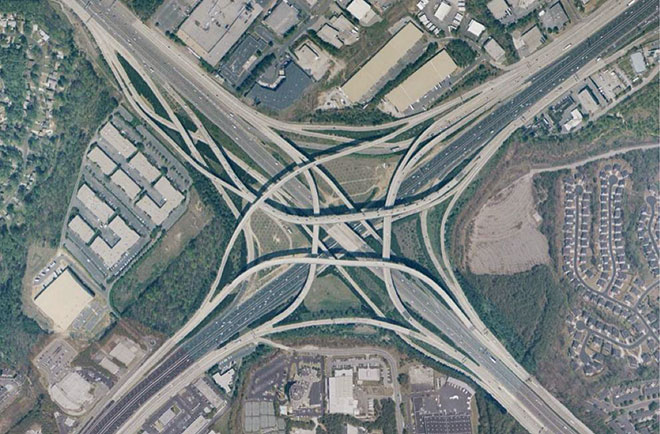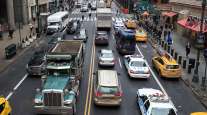Senior Reporter
2018: Atlanta’s ‘Spaghetti Junction’ Tops ATRI’s Freight Bottlenecks List Again


An aerial view of the I-85 and I-285 interchange north of Atlanta known as Spaghetti Junction. (NASA World Wind)
For the third successive year, Atlanta’s five-level stack interchange known as “Spaghetti Junction,” where Interstates 285 and 85 North intersect, is the most congested freight bottleneck in the nation, according to new research conducted by the American Transportation Research Institute.
ATRI’s 2018 study — which collected real-time GPS data from 800,000 trucks at 300 locations nationwide during calendar year 2016 — rated 100 locations in the United States with the greatest bottlenecks, measured by a combination of both speed and volume.
This year’s research showed that in many cases, including the Atlanta area, year-over-year average truck speeds declined, only worsening already serious congestion problems that ATRI has estimated cost the nation more than $63 billion annually, the equivalent of 362,000 trucks sitting idle for a year.
Ed Crowell, president of the Georgia Motor Trucking Association, said the main reason for the congestion around Atlanta’s I-285 perimeter is “simply growth.”
“The state and the region have far outstripped the capacity as it was built,” Crowell said. “It is not an easy place to add capacity.”
But Crowell noted that the Georgia Department of Transportation plans to work on doing just that, by reconfiguring interchanges and adding capacity both at the state’s two major bottlenecks and elsewhere to mitigate the traffic congestion. It’s just going to take some time.
“They will be years in the making,” Crowell said. “These are big projects.”
Atlanta is not only a major population center, it also is a freight crossroads, a central point in the Southeast for truck movements with cargo coming from the Ports of Savannah and Jacksonville, freight coming out of Florida and Tennessee, and trucks moving through Georgia to South Carolina via I-85, ATRI President Rebecca Brewster said.
One of the more striking aspects of this year’s report is the fact that the average combined rush hour speed dropped 5.5% for the top five congested locations. They included Spaghetti Junction; No. 2 Fort Lee, N.J. (I-95 at State Route 4); No. 3 Chicago (I-290 at I-90/I-94); No. 4 Atlanta (I-75 at I-285 north) and No. 5 Los Angeles (State Routes 60 at 57).
“With trucks moving slower, the congestion problem has gotten worse,” Brewster told Transport Topics.
Three new entries on this year’s top 10 list included No. 6 Boston (I-95 at I-90); Baltimore at No. 7 (I-695 at I-70) and No. 8 in Queens, N.Y. (I-495 corridor).
The top 10 was rounded out by No. 9 Cincinnati (I-71 at I-75) and No. 10 Louisville, Ky. (I-65 at I-64/I-71).
| Rank | City | Intersection |
| 1. | Atlanta | I-285 at I-85 (North) |
| 2. | Fort Lee, N.J. | I-95 at SR 4 |
| 3. | Chicago | I-290 at I-90/I-94 |
| 4. | Atlanta | I-75 at I-285 (North) |
| 5. | Los Angeles | SR 60 at SR 57 |
| 6. | Boston | I-95 at I-90 |
| 7. | Baltimore | I-695 at I-70 |
| 8. | Queens, N.Y. | I-495 Corridor |
| 9. | Cincinnati | I-71 at I-75 |
| 10. | Louisville, Ky. | I-65 at I-64/I-71 |
The study comes at a time when the Trump administration is planning to soon introduce its long-promised infrastructure improvement legislation.
“As the issue of infrastructure investment comes to the forefront on the national stage, ATRI’s report on truck bottlenecks could not come at a better time,” American Trucking Associations President Chris Spear said in a statement. “The safe and efficient movement of freight should be a top priority in any infrastructure package, and this report identified the areas where investment is most needed.”
ATRI said the bottleneck research can “empower policy and investment decision-making in the private and public sectors.”
“I do believe that, even based on earlier iterations of this list — and certainly this one — that state DOTs and the Federal Highway Administration’s freight office are looking to focus on bottlenecks as a way to target their infrastructure investment,” Brewster said. “If trucks are moving this slowly at these locations, cars are moving that slowly as well. Not only is commerce being impeded, but consumers are feeling it when they’re stuck in traffic and experience increased costs of goods being hauled in those trucks.”

Brewster
“Unfortunately, as ATRI’s report shows, increasingly our trucks are not moving because of congestion, choke points and bottlenecks on an aging highway system,” added Dennis Nash, CEO at Kenan Advantage Group, a member of ATRI’s advisory board.
That’s not to say that there weren’t improvements in some of the locations, Brewster said.
For example, this year’s No. 10 bottleneck in Louisville was No. 4 in the two prior ATRI reports.
Guy Young, president of the Kentucky Trucking Association, said recent road and bridge construction has thinned out traffic in the Louisville area.
“They repaired an existing bridge, built a new bridge and put in new interchanges on both sides of the river,” Young said. “But primarily they were looking at the Louisville side, where the biggest amount of work went on. Basically folks coming south on I-65 and east or west on I-64 and north or south on I-71 created the bottleneck.”
For more information on the ATRI study and the complete top 100 list, click here.




